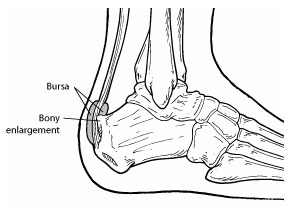|
Return to Referring Physicians Main Page
Haglund's deformity is an enlargement of the posterior aspect of the calcaneus aggravated by shoe irritation. It occurs most commonly in women who wear stylish shoes and the deformity is therefore commonly known as a "pump bump".
Symptoms of the deformity include:
- a reddened spot on the back of the heel
- a noticeable bump on the back of the heel
- swelling (bursitis)
- Achilles tendinitis

Haglund's deformity affects people with high arched feet or people with tight calf muscles that put stress on the Achilles tendon.
People with high arched feet have a calcaneus that tilts backwards (like the heel position while coming down a ladder). This places strain on the Achilles tendon. The irritation and strain of the upturned heel bone against the tendon begins to form the bony prominence we call Haglund's deformity. There are also two bursa sacs in this area that can become inflamed and painful. This is the most common source of pain associated with Haglund's deformity.
People with high arched feet tend to walk on the outside of their foot. Their calcaneus is inverted (the ankle sprain position) and in Haglund's deformity the bony excess tends to form on the outside corner of the heel. If the bony prominence is located more in the midline of the heel, this called a posterior heel spur which is directly resultant from Achilles tendinitis or rare metabolic disorders.
Podiatric Evaluation
An evaluation by the podiatrist should include:
- a history of the complaint, aggravating factors
- a biomechanical examination of the lower extremities
- x-rays of the foot and /or ankle
- inspection of footgear
An evaluation may also include:
- Diagnostic Ultrasound
- Vascular or neurologic tests
- Blood tests
- MRI, CT scan
Treatment
Conservative care is used to treat the associated tendinitis and bursitis. This includes:
- Anti-inflammatory medicines (NSAIDs)
- Rest, ice
- Heel lifts in the shoe
- Direct padding of the area
- Physical Therapy (gastrocnemieus/soleus stretching)
- Orthotics
- Cast immobilization
Surgery is a last resort and indicated if conservative measures fail to alleviate pain or the patient has the
inability to wear shoes comfortably. Surgery is usually done on an outpatient basis and simply involves removing the osseous enlargements.
Return to Referring Physicians Main Page
Our Services | Referring Physicians | About Us | Frequently Asked Questions | Blog | Articles
Surgical Animations | Links | News & Press | Photo Gallery
Contact Us | Home | Legal Notice | Privacy Statement | Site Map
Copyright © Buffalo Medical Group P.C. / Podiatry Affiliates
Website Design, Maintenance and Hosting by Catalyst Marketing / Worry Free Websites |
